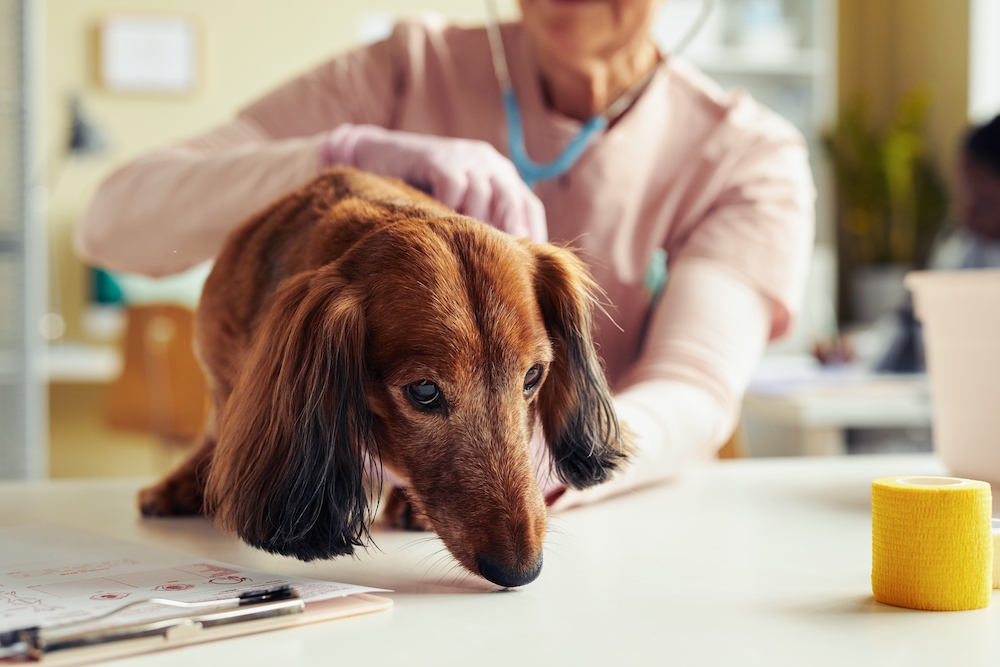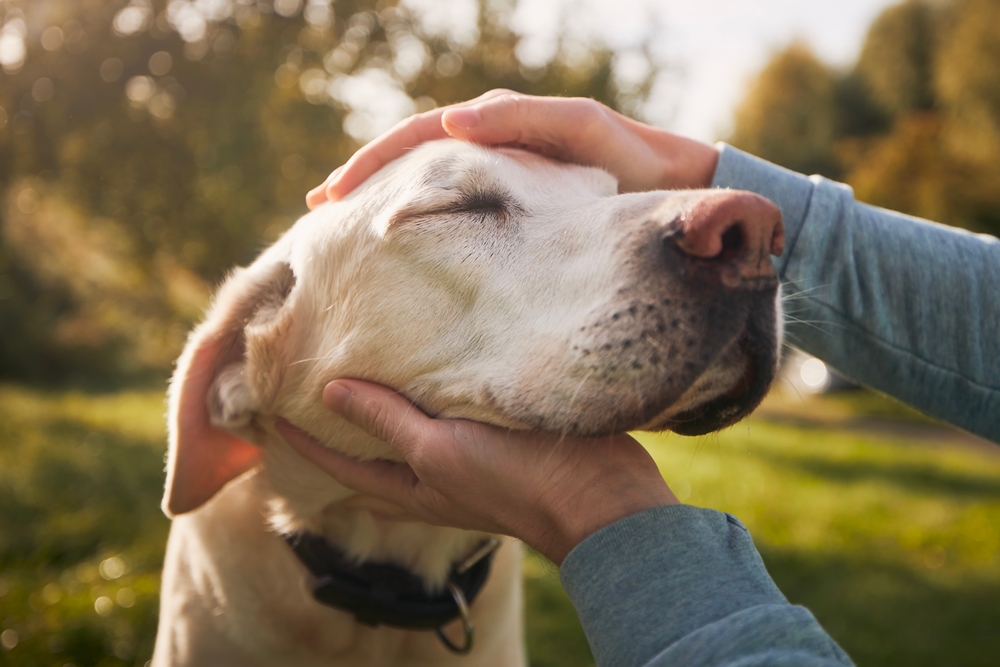If you notice that your senior dog’s back legs seem to be “collapsing” behind them—meaning that they’re not in control of their movements, they’re weak, or they’re dragging—call a veterinarian. In many cases it will be an emergency in which getting a diagnosis and starting treatment as promptly as possible can make a huge difference. If you can get in touch with your regular vet, do so. If they’re not available, try an emergency vet. Sometimes, prompt treatment can be the difference between a full recovery and permanent paralysis.
Here is some information that can help you prepare for the possibility that your senior dog will have issues with their back legs’ mobility, and do everything you can to care for them if that situation arises.

Causes of back-leg weakness in a senior dog
Hind-limb collapse can be caused by a variety of conditions, including:
- IVDD (intervertebral disc disease)
- Degenerative myelopathy
- FCE (fibrocartilaginous embolism)
- Arthritis
- Infections or inflammatory processes, including meningitis or encephalitis
- Hip dysplasia
- Tumors
- Injuries (like tears to ligaments or tendons)
Jonathan S. Block, DVM, founder of West Delray Veterinary in Florida, emphasizes that it’s an emergency if a dog suddenly loses function in their hind limbs and shows that through signs like dragging them, having trouble getting up on their own, or walking with a wobbly or uncoordinated gait.
“Usually,” Dr. Block says, such events “come on without any warning.” They can be signs that a dog has IVDD (a ruptured or herniated disc in the spine) or FCE (a vascular event that can cause limb weakness). In those cases, immediate veterinary attention is vital. Getting a proper diagnosis and beginning treatment right away can improve a dog’s prognosis immensely.
While conditions like IVDD are more common in breeds like dachshunds and French bulldogs, and degenerative myelopathy is most common in German shepherds and some other breeds, they can afflict any dog.
In older dogs, the most common cause of a more gradual loss of hind-limb function is arthritis. “In that situation,” says Dr. Block, “it’s usually not a surprise to the owner. It’s just a slow progression.” In fact, Dr. Block says, almost all dogs who reach a certain age, just like almost all people who reach a certain age, will show signs of arthritis if you look closely enough. This doesn’t mean, however, that all of them will have mobility problems.
While the range of possibilities for why a dog’s back legs aren’t functioning correctly is wide, what you should do first if your dog can’t get up is simple. “Any time a dog is unable to get up on their own and that is a change,” says Dr. Block, “that does warrant outreach to either their primary veterinarian—or, if it’s off hours, to an emergency veterinarian.”
What the vet will do if you bring your senior dog in with collapsing back legs
If you bring your dog to the veterinarian because their back legs are collapsing, you can expect them to ask you some questions and perform a thorough orthopedic exam to assess how your dog is able to move. The vet may test your dog’s reflexes and watch how they walk. They may also check vital signs and take blood samples, or perform imaging tests like X-rays, to figure out what’s causing your dog’s issues and what type of treatment will be most likely to help them. They’ll then work with you to make a treatment plan.

How to help a senior dog get better from collapsing back legs
There’s no single way to help a dog recover from collapsing back legs, because every dog is different and so many different conditions cause a loss of function in dogs’ back legs.
“For example,” Dr. Block says, “an acute disc herniation [like those seen in IVDD] is often treated surgically, but can also be managed conservatively with pain medication, rest, and time.” Arthritis will usually be managed without surgery, unless it’s a result of hip or elbow dysplasia that requires its own treatment. Tears to tendons and ligaments can require surgery. In some cases, even if surgery is an option for something like an ACL injury, a veterinarian may recommend lifestyle changes first. “If a dog is significantly overweight,” says Dr. Block, “we might recommend strict weight loss before we even consider approaches to surgery, because fitness and body condition have a huge impact on outcome.”
Physical therapy can also be a key part of dogs’ recovery from many of these conditions—but never attempt a PT program without talking to a veterinarian first. Exercises that have worked for some dogs—even a particular dog at a different point in their life—could be harmful if undertaken at the wrong time.
These are just some of the many treatment possibilities. Depending on the circumstances, veterinarians may use tools and techniques like heat and cold therapy, acupuncture, massage, and many others on a dog with leg problems. That’s one reason it’s important to bring your dog in and get advice from a medical professional.
Subtler signs to watch for, and how to prevent a senior dog from losing back-leg function
While sudden loss of hind-limb function can be scary, and often comes about without warning, sometimes dogs show subtler signs that they’re having trouble with their limbs. These can include:
- Difficulty going from sitting to standing, or getting up when they were laying down.
- Slipping on smooth surfaces like tile or hardwood floor when they’re getting around fine on carpeting or grass
- Limping
- Abnormal gait
- Less tolerance for exercise
“If you’re used to going on 2-mile walks,” says Dr. Block, “and all of a sudden your dog gets tired and doesn’t want to go after half a mile, that can usually be a sign that something is going on.” If you notice a change along these lines, don’t hesitate to bring your dog to the vet for an exam.
Giving your dog an appropriate amount of exercise and proper nutrition, and keeping them in a healthy body condition, can improve their chances of avoiding the collapse of their back legs. Dr. Block advocates “controlled” exercise—certain activities, like those involving high jumps, can involve more injury risk.
But, unfortunately, there’s nothing you can do to guarantee that a dog’s back legs will never collapse.
“Sometimes these things just happen,” says Dr. Block, “as freak accidents [with] no forewarning. And we don’t know if it’s genetic or just bad luck.” So give your dog the best chance to remain healthy, but don’t blame yourself if they end up needing veterinary attention.
And even for dogs who do get injured or need treatment for another condition, good general health is an asset. “If they’re healthier going into the injury,” says Dr. Block, “they’re going to have an improved potential outcome.”
If your dog’s back legs aren’t moving correctly, call your vet
The bottom line here is that if your dog is having trouble moving their back legs, you should get in touch with a vet immediately. While many different conditions can cause the apparent collapse of a dog’s back legs, it’s best to be proactive about getting them diagnosed.









